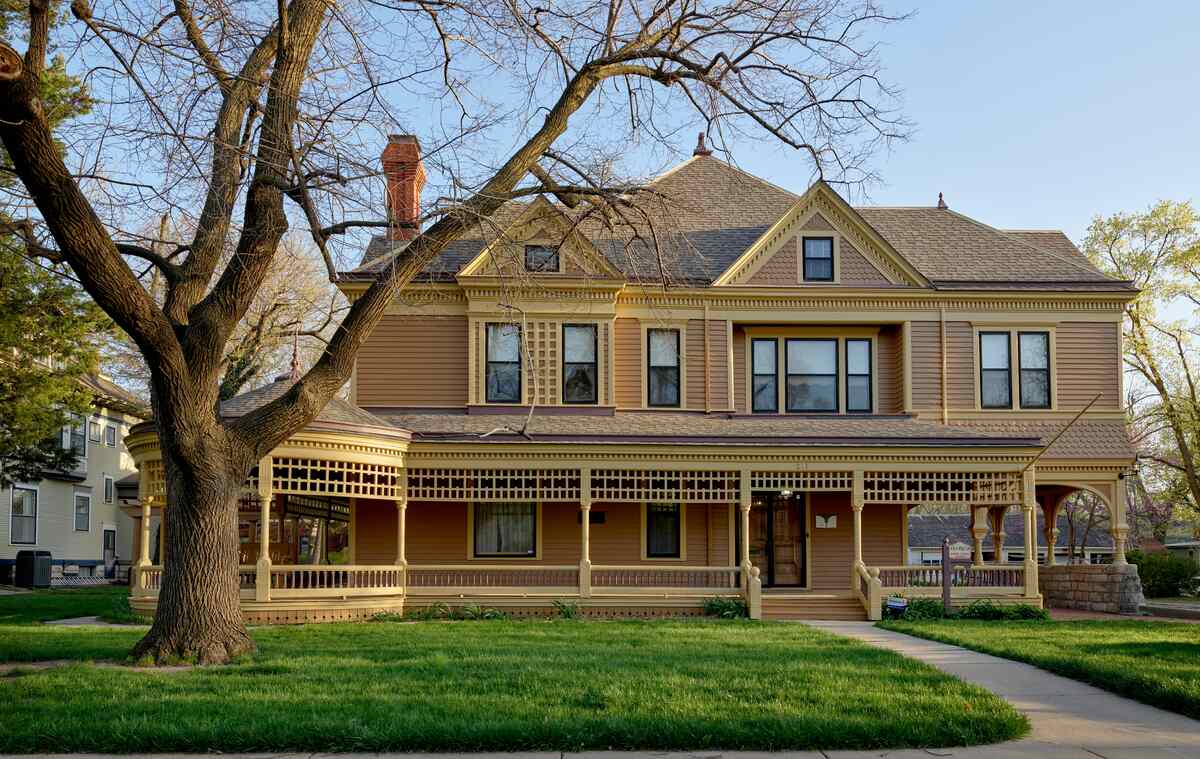
Want an impressive lawn in Kansas? Then you need to understand our climate and soil. Picking the right grass seed is the first step to ensuring your lawn survives and thrives in the Sunflower State’s unpredictable weather.
So, just what is the best grass seed for lawns in Kansas? Bermudagrass, buffalograss, Zoysiagrass, fine fescue, Kentucky bluegrass, perennial ryegrass, and tall fescue can work, but it depends where in the state you live and what you want out of your lawn.
We’ve broken down the top picks, so you can spend less time worrying and more time enjoying your little slice of green Kansas heaven.
Warm-Season vs. Cool-Season Grasses
Kansas has scorching summers, frosty winters, and considerable temperature fluctuations year-round. While the Southern part of the state provides an ideal environment for warm-season grasses, the Northern regions are better suited for cool-season grass varieties.
Central Kansas is in the transition zone, where both types of grass can grow and thrive. This allows more wiggle room when picking your grass seed, so you can find something that suits your preferences and landscape.
Best Warm-Season Grasses for Kansas
When selecting warm-season grasses suitable for Kansas, you’ll find numerous options to meet your needs. Let’s examine the top varieties:
Bermudagrass (Cynodon dactylon)
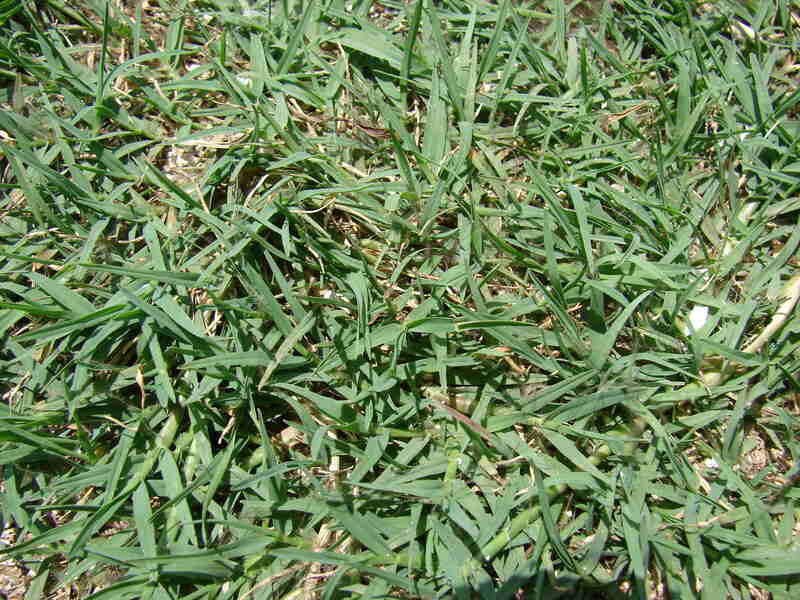
Photo Credit: Forest and Kim Starr / Flickr / CC BY 2.0
Bermudagrass is a warm-season grass that is native to tropical and subtropical regions worldwide. This grass type grows best from late spring through summer and handles drought well. Since bermudagrass lawns are less tolerant of cold temperatures than Zoysia or cool-season grasses, their use is limited to the south of the transition zone in Kansas.
This coarse grass has the fastest growth rate of all warm-season grasses, making it difficult to control sometimes. On the flip side, it can handle heavy foot traffic, which is a plus for big families or those with pets.
- Classification: Warm-season grass
- Spreads by: Stolons and rhizomes
- Shade tolerance: Low – some varieties need more sun than others
- Drought tolerance: High – may go dormant during long periods of drought
- Foot traffic tolerance: High
- Maintenance needs: Moderate to high – requires frequent watering, fertilization, and mowing to maintain its appearance and health
- Recommended mowing height: 1-2 inches – raise the mower height during periods of drought or extreme heat
- Potential for disease and pests: Moderate (common diseases include dollar spot, large patch, leaf spot, and spring dead spot; can be prone to armyworms, bermudagrass mites, and nematodes)
- Soil pH: 6-6.5
- Soil type: Grows in most soil types
- Preferred Kansas region: Southern and Central
Other notes: It has the impressive ability to propagate itself rapidly, but this may result in the grass taking over and invading nearby flower beds or other cultivated areas.
Grass Seed Options:
– Pennington Bermudagrass Bare Spot (5 lb. bag)
– Pennington Smart Seed Bermudagrass Mix (8.75-lb. bag)
– Scotts Turf Builder Bermudagrass (10-lb. bag)
– Hancock Seed Co. Bermudagrass (50-lb. bag)
Buffalograss (Buchloë dactyloides)
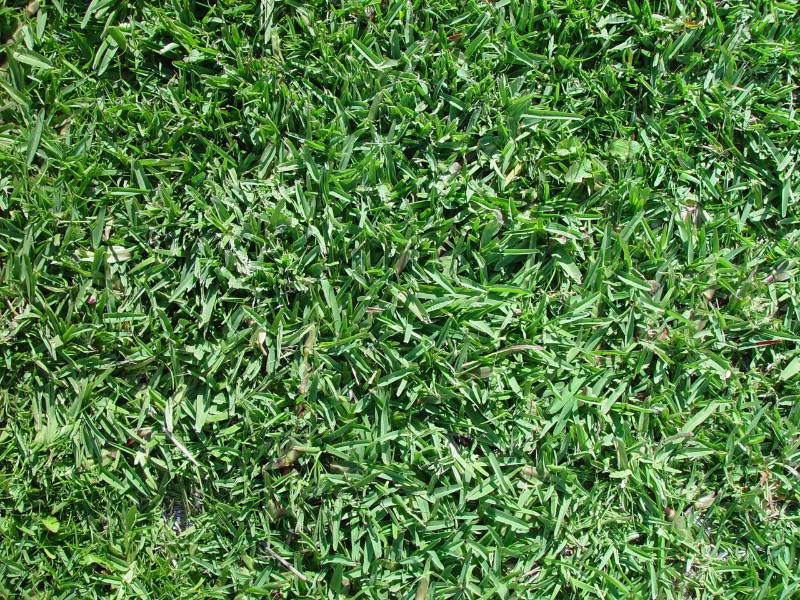
Photo Credit: Titus Tscharntke / Pixnio / CC0 1.0
Highly drought-tolerant and impressively low-maintenance, buffalograss lawns are suited for regions with water restrictions thanks to a deep root system, which can access water stored in the soil.
Buffalograss thrives in hot temperatures, greening up in the spring and turning brown in winter. It grows slowly and requires minimal mowing, fertilization, or watering to survive.
This grass variety is an excellent choice if you’re looking to establish a fine-textured, soft lawn. Once mature, buffalograss forms a dense turf that not only looks stunning but is also frequently used to prevent soil erosion on hills and slopes.
- Classification: Warm-season grass
- Spreads by: Stolons
- Shade tolerance: High
- Drought tolerance: High
- Foot traffic tolerance: High
- Maintenance needs: Low
- Recommended mowing height: 1-2 inches
- Potential for disease and pests: High
- Soil pH: 6-7.5
- Soil type: Well-drained loam or clay
- Preferred Kansas region: Western and Central
Other notes: Best planted from late spring to early summer, though plugs or sod work as late as August or September. It grows exceptionally well throughout most of the U.S., which is rare.
Grass Seed Options:
– Everwilde Farms Buffalograss Seeds (1 lb. of seeds)
– Scotts Pursue Buffalograss with Natural Seed (1 lb. of seeds)
– Outsidepride Perennial Buffalo Grass Seed (2 lb. of seeds)
Zoysiagrass (Zoysia)

Photo Credit: Forest and Kim Starr / Wikimedia Commons / CC BY 3.0 US
Zoysiagrass grows well in full sun and partial shade, producing a thick, attractive lawn when established and maintained. Compared to other grasses, Zoysia grows slower and is typically established through sodding or plugging. Its resilience to drought, heat, and winter conditions makes it an appealing choice for Kansas homeowners.
Maintaining a Zoysiagrass lawn is fairly easy. However, depending on your soil, you may need to fertilize it three times throughout the summer growing season. Additionally, it should be mowed as low as possible, being sure to avoid scalping.
- Classification: Warm-season grass
- Spreads by: Stolons and rhizomes
- Shade tolerance: Low to moderate
- Drought tolerance: High – although it needs supplemental watering during dry periods
- Foot traffic tolerance: High
- Maintenance needs: Low to moderate
- Recommended mowing height: 1-2.5 inches
- Potential for disease and pests: Moderate (common diseases include fairy rings, dollar spot, brown patch, powdery mildew, pythium blight, rust, large patch, spring dead spot, leaf spot, root decline, chinch bugs, Zoysiagrass mites, and mole crickets)
- Soil pH: 6-6.5
- Soil type: Grows in most soil types but prefers well-drained soils
- Preferred Kansas region: Southern and Central
Other notes: Homeowners who love hosting BBQ parties in their yards prefer this grass variety because of its foot traffic tolerance.
Grass Plug and Seed Options:
– Zoysia Plugs (50 Large Grass Plugs)
– Zoysia Plugs (50 Full & Lush Grass Plugs)
– Zoysia Plugs (100 Plugs)
– Zoysia Emerald Grass Seeds (1/8 lb. of seeds)
– Zenith Zenith Grass Seeds (1/8 lb. of seeds)
Best Cool-Season Grasses for Kansas
With Northern Kansas’ finicky weather, selecting a grass variety that can withstand temperature extremes is important. In this section, we’ll explore the best cool-season grasses for Kansas.
Fine Fescue (Festuca arundinacea)

Photo Credit: Aaron J. Patton, Ph.D. / Purdue’s Turfgrass Science Program
Fine fescue is a medium green to blue-green grass. It has the thinnest blades, the most shade tolerance, and the lowest moisture and fertilizer needs of common cool-season grasses. It’s also drought-resistant and remains green all year.
If you’re a lawn care beginner, this is the ideal turfgrass. However, fine fescue doesn’t do well in high-traffic areas. If your kids or pets regularly run around your property, you might want to choose another variety.
- Classification: Cool-season grass
- Spreads by: Bunch-type grasses with one exception: creeping red fescues possess rhizomes
- Shade tolerance: Moderate to high
- Drought resistance: Moderate to high
- Foot traffic tolerance: Low to moderate
- Maintenance needs: Low mowing frequency
- Mowing height: 1.5-3 inches
- Potential for disease and pests: Moderate to high
- Soil pH: 5.5-6.5
- Soil type: Good drainage is a must; tolerates infertile soils; sandy soils generally work well
- Preferred Kansas region: Northern and Central
Other notes: Often used in a mix with other cool-season grasses, especially in sun/shade mixes.
Grass Seed Options:
– Outsidepride Legacy Fine Fescue Grass Seed (5 lbs.)
– Eretz Creeping Red Fine Fescue Seed (choose your size)
– Outsidepride Creeping Red Fine Fescue Grass Seed (25 lbs.)
– Outsidepride Hard Fine Fescue Grass Seed (10 lbs.)
Kentucky Bluegrass (Poa Pratensis)
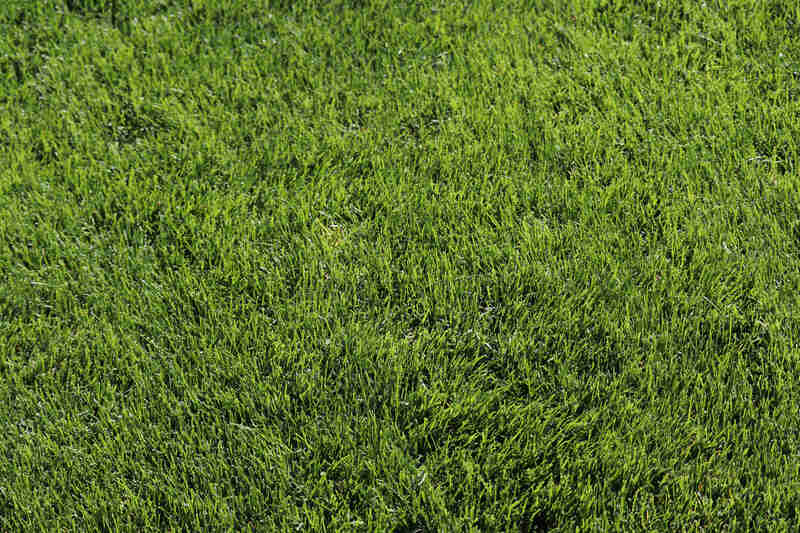
Photo Credit: Joshua Boman / Shutterstock
KBG or Kentucky bluegrass is a high-maintenance, high-quality grass with deep roots that requires regular watering and fertilizing. It forms a dense, soft, fine-textured lawn that feels fantastic underfoot, making it a popular choice for residential and recreational areas.
KBG can recover quickly, making it ideal for foot traffic and frequent games of catch with your furry friend. Another point in its favor is that it’s cold-hardy, allowing it to remain green and vibrant despite the harsh Kansas winters.
However, this grass type takes about six months to thicken during the spring green-up and may struggle during periods of drought. Maintenance may also prove challenging if you live in an area with water restrictions.
- Classification: Cool-season grass
- Spreads by: Rhizomes
- Shade tolerance: Low to moderate — prefers full sun
- Drought resistance: Moderate, but will survive by going dormant
- Foot traffic tolerance: Low to moderate, but recuperates well
- Maintenance needs: Moderate mowing frequency; a high-maintenance grass
- Mowing height: 2-3 inches
- Potential for disease: Moderate to high
- Soil pH: 6-7
- Soil type: Good drainage, fertile
- Preferred Kansas region: Northern and Central
Other notes: Under ideal conditions, it produces a dense lawn. Many of its traits vary widely by cultivar, with newer cultivars generally being hardier and more disease-resistant. It’s most often mixed with other species, such as tall fescue, in home lawns.
Grass Seed Options:
– Jonathan Green (11970) Blue Panther Kentucky Bluegrass Grass Seed (3 lbs.)
– SeedRanch Midnight Kentucky Bluegrass Seed (5 lbs.)
– Jacklin Seed – Biltmore Blue Blend – 100% Kentucky Bluegrass (5 lbs.)
Perennial Ryegrass (Lolium perenne)
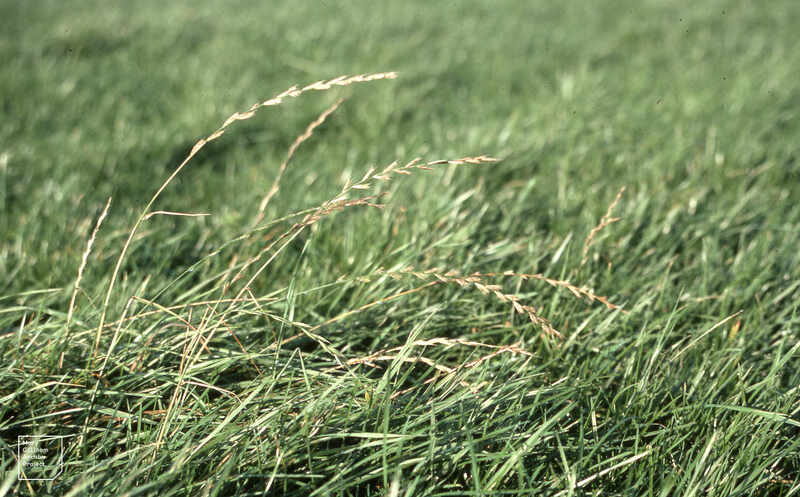
Photo Credit: Dr Mary Gillham Archive Project / Flickr / CC BY 2.0
Perennial ryegrass is popular across the U.S., but its application varies from region to region. This grass type produces a deep green color and glossy texture and has the highest traffic tolerance of any cool-season grass.
Often used around homes, schools, athletic fields, and parks throughout Kansas, this fine-textured grass is versatile, winning major points for its fast germination rate, quick establishment, and disease resistance.
While not as cold-hardy as Kentucky bluegrass or tall fescue, perennial ryegrass remains green in moderate summers and cool winters.
- Classification: Cool-season grass
- Spreads by: Bunch-type grass
- Shade tolerance: Low — prefers full sun
- Drought resistance: Low (summer dormancy in some areas)
- Foot traffic tolerance: High, but has poor recuperative ability
- Maintenance needs: Moderate mowing requirement, depending on cutting height (lower cutting heights require more frequent mowing)
- Mowing height: 2-3 inches
- Potential for disease and pests: Moderate to high
- Soil pH: 5.5-7.5
- Soil type: Well-draining, highly fertile
- Preferred Kansas region: Eastern and Central
Other notes: Most often mixed with Kentucky bluegrass and fine fescue in a cool-season mix.
Grass Seed Options:
– Outsidepride Perennial Ryegrass Seed (5 lbs.)
– Eretz ProTurf Perennial Ryegrass Fine Lawn Seed (choose your size)
Tall Fescue (Festuca arundinacea)
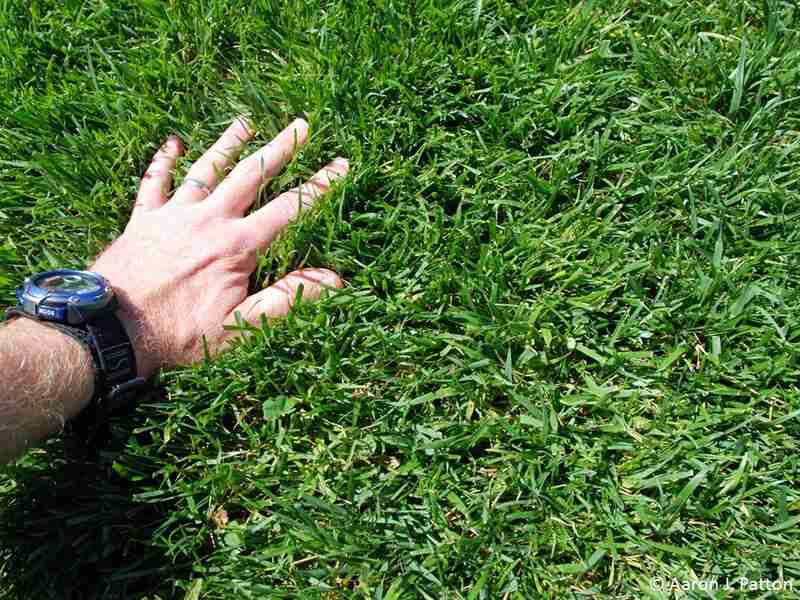
Photo Credit: Aaron J. Patton, Ph.D. / Purdue’s Turfgrass Science Program
Tall fescue is a resilient, dark green grass with a coarse texture. It’s perfect for areas that don’t get much sun and is often found on athletic fields and playgrounds. It bounces back from damage caused by pets or athletic activities, which makes it perfect for recreational areas.
This grass seed grows in full sun and partial shade and can handle both wet and dry soil. Tall fescue is a popular choice, establishing quickly and creating shorter, denser, and darker green lawns than other varieties.
- Classification: Cool-season grass
- Spreads by: Bunch-type grass
- Shade tolerance: Moderate
- Drought resistance: High
- Foot traffic tolerance: High
- Maintenance needs: Grows fast, so plan to mow quite a bit.
- Mowing height: 2-4 inches
- Potential for disease and pests: Moderate to high
- Soil pH: 5.5-6.5
- Soil type: Well-draining and fertile but will tolerate a wider range of soil conditions
- Preferred Kansas region: Eastern, Northeastern
Other notes: Reseed every few years to repair bare spots and thinning.
Grass Seed Options:
– Triple-Play Tall Fescue Grass Seed Blend (5000 sq ft)
– Eretz Kentucky 31 K31 Tall Fescue Grass Seed (choose your size)
– Pennington The Rebels Tall Fescue Grass Seed Mix (7 lb.)
When to Plant Grass Seed in Kansas
The best time to plant grass seed in Kansas depends on the type of grass you want to grow and your region. Generally, sow warm-season grass seed from mid-April to mid-May, but wait until September or October to seed cool-season cultivars. You can also seed cool-season grass from March to April if you miss the fall planting window.
FAQ About the Best Grass Seed for Lawns in Kansas
Zoysiagrass is one of the easiest turfgrasses to maintain. It can withstand drought and survive in poor soil conditions with little upkeep. It’s also disease- and pest-resistant and grows slowly but densely, blocking weed growth.
A bermudagrass lawn can withstand wear and tear and provide an excellent playing field for your furry friend. This grass type is an excellent choice due to its deep roots and ability to handle heavy paw traffic.
Overseed your existing lawn with the same grass type. You can also opt to overseed with perennial ryegrass. It germinates quickly, grows well in mixes, and helps winterize warm-season grasses for a year-round green lawn in Kansas.
Mow cool-season grasses when temperatures reach 50 degrees Fahrenheit, around late March or early April, and start mowing warm-season varieties around May. Wait until the grass reaches 3 to 4 inches to begin mowing and increase the frequency as the weather warms. Aim for a regular mowing schedule to promote a dense lawn.
Most grasses stop growing when temperatures drop below 55 degrees Fahrenheit. With growth halting, you can stop mowing your Kansas lawn around late October. Keep an eye on the weather. Short spurts of warmer weather can activate sporadic growth, especially in the fall.
For more tips, check out our Kansas lawn care schedule.
Proper Lawn Care Pays Off
When you’re looking for the perfect grass seed for your Kansas lawn, consider your location, your yard’s sun exposure, soil type, and the time you can commit to maintenance. Whether you choose bermudagrass, Zoysiagrass, fine fescue, or any other cultivar, a well-maintained lawn is the difference between fab and drab.
Don’t sweat if you’re short on time or not into yard work. A Kansas LawnStarter Pro can do the heavy lifting, so you can have more time to do the things you love.
LawnStarter participates in the Amazon Services LLC Associates Program, an affiliate advertising program. LawnStarter earns revenue from products promoted in this article.
Main Image Credit: Carol M Highsmith / Rawpixel / CC0 1.0